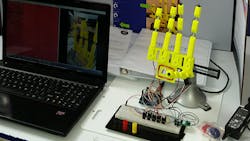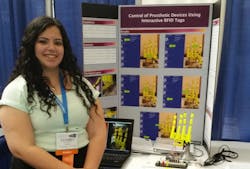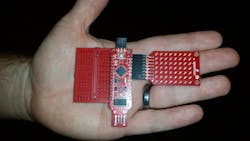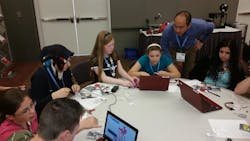#IntelISEF Students Flock to Pittsburgh for Director’s Farewell Bash
Wendy Hawkins, executive director at Intel Foundation, is retiring this year and turned this year’s Intel International Science and Engineering Fair (ISEF) into a giant retirement party. She didn’t want to spend it with politicians and naysayers. She wants to spend it with thousands of students who will be solving the challenges of the world. It is quite a party and this was only the opening ceremony.
I have written about science competitions, including Intel ISEF, for many years (see “Intel International Science and Engineering Fair Invades Pittsburgh”). For those unfamiliar with it, there are over 1,000 of the top students from around the world competing in Pittsburgh this week. They were chosen in state, regional, and national science fairs for projects that touch every science, engineering, and technology category. Many projects have turned into products and a vast majority of alumni are now scientists and engineers.
This year I am accompanying the winner of the Mercer Science and Engineering Fair to Intel ISEF. Sandra Baskharon is a junior at Steinert High School (Hamilton High East) in New Jersey. Her project is entitled “Control of Prosthetic Devices Using Interactive RFID Tags” (Fig. 1). It uses an Arduino board to control a 3D-printed, prosthetic hand she designed. An RFID sensor is located in the palm.
1. Sandra Baskharon is representing the Mercer Science and Engineering Fair at the Intel ISEF competition in Pittsburgh. Her project, "Control of Prosthetic Devices Using Interactive RFID Tags" uses an Arduino board to control the 3D-printed hand she designed.
It was probably fortuitous that Sandra attended one of the symposium sessions for the students that was run by SparkFun. Each student received a new BadgerStick (Fig. 2). ISEF students get a crack at it, but at this point it is not a SparkFun product. The details can be found on the BadgerHack page. Hopefully it will turn into a product because the form factor and features are very nice. The LED array has sample applications for scrolling text, and Derek Runberg, educational technologist for SparkFun, had students scrolling text in under an hour. That was after getting them to blink an LED or two.
2. The BadgerStick is a tiny, Arduino-compatible board that is low-cost and interfaces easily with breakout boards and other expansion boards.
Of course, this example tends to be a little biased. Over half of the attendees know about Arduino, and half of those used a version in their projects. They also used the same open-source tools available for Arduino users.
The session was full and they were turning away students because all the seats were taken in the session we attended. Most of the adults like me were on the sidelines watching while the three SparkFun employees waded through the crowd giving advice and encouragement. It was a lot of fun for all. For those worried about not enough women in the workplace, it is not a problem here (Fig. 3). The interest and expertise are there. It remains for the old guard like us to continue to foster their interest.
Derek has some fun comments along the way. The LED example did not have a resister and one of the students caught that. The explanation was the board’s drivers were limited to 40 ma, which is twice what the LEDs were rated at but they tend to be overdesigned. Besides, the demo is blinking the LEDs. Don’t you just love engineering?
The opening ceremony started with an Xpogo demo that was an impressive physics demonstration. Who knew pogo sticks could be so much fun? There was Wendy’s keynote as well as one from Intel’s futurist, Brian David Johnson. Brian talked about superheroes and how the students fit that profile ending with the quote, “Will you join me to save the future?”
The final speaker was Luis Von Ahn, a Guatemalan entrepreneur and an associate professor in the Computer Science Department at Carnegie Mellon University (CMU). He is founder and CEO of reCAPTCHA (now owned by Google) and Duolingo. Duolingo lets you learn another language for free. He talked about two approaches used in these two platforms that got the audience very interested. The first was how they use captcha to help translate scanned books. It turns out that there is a reason for giving two words in the latest captcha prompts. One is the known word and one you need to match. The other is a scanned word and the result is used to identify the word. Multiple-user responses are combined to determine what the word actually is, but it puts the massive brainpower used for the billions of captcha entries to a useful cause.
For Duolingo, the chore is translating from one language to another. Users need the practice and companies need information translated. That homework Doulingo users are doing generates the cash to keep the project running. Not a bad tradeoff. It tends to have an equalizing effect on the availability of teaching/learning services and the desire is to move past just languages to more ambitious topics.
Intel ISEF always brings surprises like this, but the best is yet to come. The students are prepping for the full day of judging and the public will get to view the projects on Thursday. I’ll hopefully get a few photos and post them in another article. There are hundreds of projects and I tend to bias toward computer and engineering projects, but we shall see.
In the meantime, if you are ever around when there is a science-fair competition, stop by and visit. It is a lot of fun and you might learn something, or at least be impressed. Better yet, get involved regardless of your background. It is very rewarding. For me, we are off to tour CMU. It might be where Sandra winds up in a couple years.
About the Author
William Wong Blog
Senior Content Director
Bill's latest articles are listed on this author page, William G. Wong.
Bill Wong covers Digital, Embedded, Systems and Software topics at Electronic Design. He writes a number of columns, including Lab Bench and alt.embedded, plus Bill's Workbench hands-on column. Bill is a Georgia Tech alumni with a B.S in Electrical Engineering and a master's degree in computer science for Rutgers, The State University of New Jersey.
He has written a dozen books and was the first Director of PC Labs at PC Magazine. He has worked in the computer and publication industry for almost 40 years and has been with Electronic Design since 2000. He helps run the Mercer Science and Engineering Fair in Mercer County, NJ.
- Check out more articles by Bill Wong on Electronic Design
- Bill Wong on Facebook
- @AltEmbedded on Twitter



